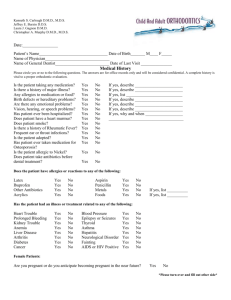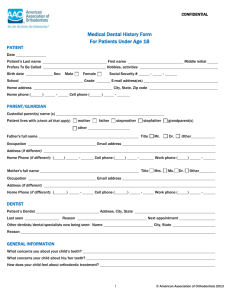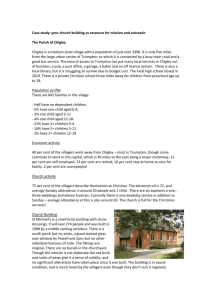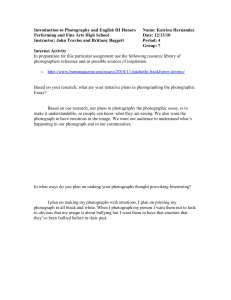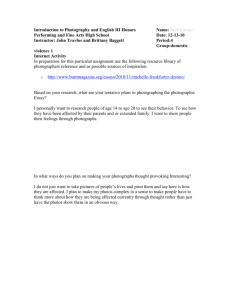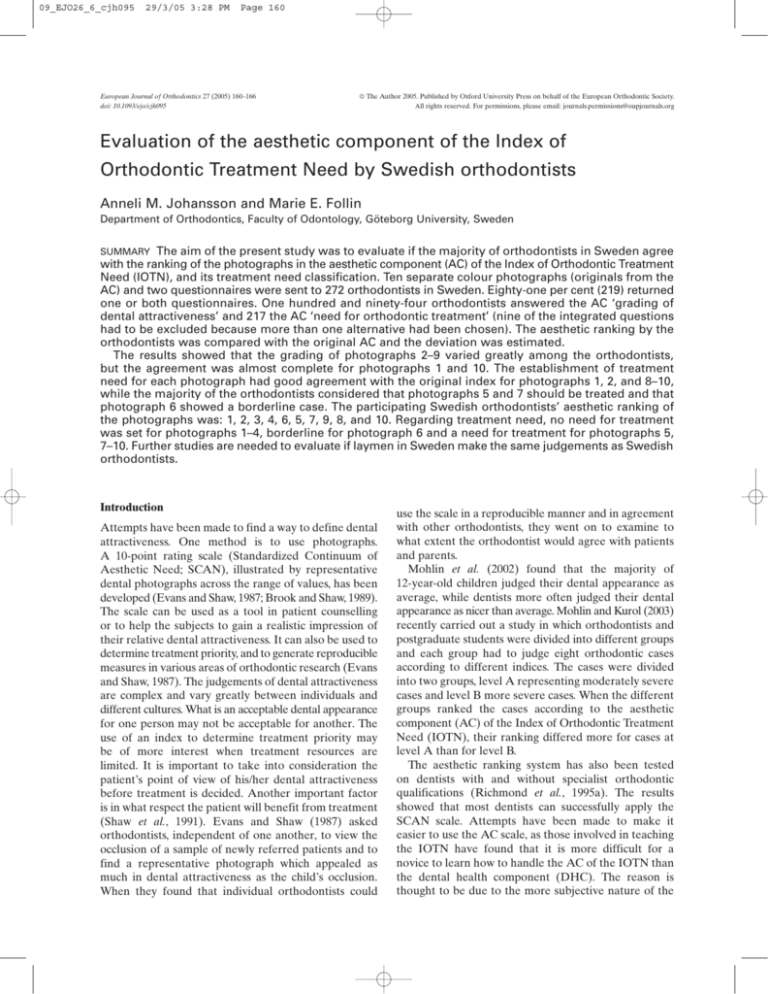
09_EJO26_6_cjh095
29/3/05 3:28 PM
Page 160
European Journal of Orthodontics 27 (2005) 160–166
doi: 10.1093/ejo/cjh095
The Author 2005. Published by Oxford University Press on behalf of the European Orthodontic Society.
Αll rights reserved. For permissions, please email: journals.permissions@oupjournals.org
Evaluation of the aesthetic component of the Index of
Orthodontic Treatment Need by Swedish orthodontists
Anneli M. Johansson and Marie E. Follin
Department of Orthodontics, Faculty of Odontology, Göteborg University, Sweden
SUMMARY The aim of the present study was to evaluate if the majority of orthodontists in Sweden agree
with the ranking of the photographs in the aesthetic component (AC) of the Index of Orthodontic Treatment
Need (IOTN), and its treatment need classification. Ten separate colour photographs (originals from the
AC) and two questionnaires were sent to 272 orthodontists in Sweden. Eighty-one per cent (219) returned
one or both questionnaires. One hundred and ninety-four orthodontists answered the AC ‘grading of
dental attractiveness’ and 217 the AC ‘need for orthodontic treatment’ (nine of the integrated questions
had to be excluded because more than one alternative had been chosen). The aesthetic ranking by the
orthodontists was compared with the original AC and the deviation was estimated.
The results showed that the grading of photographs 2–9 varied greatly among the orthodontists,
but the agreement was almost complete for photographs 1 and 10. The establishment of treatment
need for each photograph had good agreement with the original index for photographs 1, 2, and 8–10,
while the majority of the orthodontists considered that photographs 5 and 7 should be treated and that
photograph 6 showed a borderline case. The participating Swedish orthodontists’ aesthetic ranking of
the photographs was: 1, 2, 3, 4, 6, 5, 7, 9, 8, and 10. Regarding treatment need, no need for treatment
was set for photographs 1–4, borderline for photograph 6 and a need for treatment for photographs 5,
7–10. Further studies are needed to evaluate if laymen in Sweden make the same judgements as Swedish
orthodontists.
Introduction
Attempts have been made to find a way to define dental
attractiveness. One method is to use photographs.
A 10-point rating scale (Standardized Continuum of
Aesthetic Need; SCAN), illustrated by representative
dental photographs across the range of values, has been
developed (Evans and Shaw, 1987; Brook and Shaw, 1989).
The scale can be used as a tool in patient counselling
or to help the subjects to gain a realistic impression of
their relative dental attractiveness. It can also be used to
determine treatment priority, and to generate reproducible
measures in various areas of orthodontic research (Evans
and Shaw, 1987). The judgements of dental attractiveness
are complex and vary greatly between individuals and
different cultures. What is an acceptable dental appearance
for one person may not be acceptable for another. The
use of an index to determine treatment priority may
be of more interest when treatment resources are
limited. It is important to take into consideration the
patient’s point of view of his/her dental attractiveness
before treatment is decided. Another important factor
is in what respect the patient will benefit from treatment
(Shaw et al., 1991). Evans and Shaw (1987) asked
orthodontists, independent of one another, to view the
occlusion of a sample of newly referred patients and to
find a representative photograph which appealed as
much in dental attractiveness as the child’s occlusion.
When they found that individual orthodontists could
use the scale in a reproducible manner and in agreement
with other orthodontists, they went on to examine to
what extent the orthodontist would agree with patients
and parents.
Mohlin et al. (2002) found that the majority of
12-year-old children judged their dental appearance as
average, while dentists more often judged their dental
appearance as nicer than average. Mohlin and Kurol (2003)
recently carried out a study in which orthodontists and
postgraduate students were divided into different groups
and each group had to judge eight orthodontic cases
according to different indices. The cases were divided
into two groups, level A representing moderately severe
cases and level B more severe cases. When the different
groups ranked the cases according to the aesthetic
component (AC) of the Index of Orthodontic Treatment
Need (IOTN), their ranking differed more for cases at
level A than for level B.
The aesthetic ranking system has also been tested
on dentists with and without specialist orthodontic
qualifications (Richmond et al., 1995a). The results
showed that most dentists can successfully apply the
SCAN scale. Attempts have been made to make it
easier to use the AC scale, as those involved in teaching
the IOTN have found that it is more difficult for a
novice to learn how to handle the AC of the IOTN than
the dental health component (DHC). The reason is
thought to be due to the more subjective nature of the
09_EJO26_6_cjh095
29/3/05 3:28 PM
Page 161
161
E VA L UAT I O N O F T H E AC O F T H E I OT N
AC and the trainee’s tendency to try to match a subject’s
malocclusion with a photograph using morphological
similarities rather than equivalence on a continuum of
attractiveness (Burden, 1995). That author therefore
reduced the number of photographs in the AC of the
IOTN to determine if fewer illustrations allowed greater
calibration of the judgement of dentists, i.e. to evaluate
if fewer photographs could act as ‘anchor’ photographs
to rank dental attractiveness. He found that there was a
tendency to underscore when the number of photographs was reduced to two, and the agreement with the
‘gold standard’ scores was also less.
Ranking dental attractiveness is subjective and may
be systematically related to the judge’s demographic
background. Howells and Shaw (1985) found that laymen
as a group ranked photographs for dental and facial
attractiveness systematically according to their own
demographic background. The age of the judges and
their social class were highly significant factors in determining ratings of dental attractiveness. The validity of
the AC of the IOTN has been tested in the UK with
good agreement (Shaw et al., 1995). During recent years,
the use of occlusal indices has become more common in
Europe. However, no study has been undertaken to
determine whether the ranking of the photographs in
the AC of the IOTN will be the same for dentists in
different countries in Europe.
The aims of the present study were: (1) to evaluate
if orthodontists in Sweden agree with the ranking of
the photographs in the dental attractiveness scale (AC);
(2) to evaluate if they have the same opinion about
which subjects, according to the scale, should be treated,
not treated or who are borderline; and (3) to eventually
suggest a Swedish scale.
Materials and methods
Two questionnaires and a set of 10 colour photographs
showing different levels of dental attractiveness were
sent to 272 orthodontists in Sweden (listed as active
members of the Swedish Association of Orthodontists).
In the first questionnaire, the orthodontists were asked
about their background (such as year of birth, gender,
where and the year they became a licensed orthodontist,
their years working as an orthodontist, if they presently
worked as an orthodontist and, if they did, was it in
the private, community or university sector). They were
asked about their personal use of treatment need indices
and if they had been trained in their use. Finally, there
was also room for comments.
In the second questionnaire, the orthodontists were
asked about the AC of the IOTN. The 10 photographs
were copies of the originals used by Evans and Shaw
(1987) (Figure 1), but they were marked with symbols
instead of figures and each participant had 10 separate
photographs to look at. The order in which each
photograph’s symbol was presented in the questionnaire
was randomized. The orthodontist was asked to state
their opinion on, where on the aesthetic scale from 1
(most aesthetic) to 10 (least aesthetic) the photograph
should be placed (‘dental attractiveness’), as well as the
treatment priority (need for treatment, borderline, or
no treatment need). The orthodontists were then asked
to return the material to one of the authors (AJ) who
processed all the answers.
Results
The questionnaires were sent to 272 orthodontists.
Thirty-six did not respond and 17 indicated that they
did not want to participate. In total, 53 (19 per cent) did
not participate in the study (21 females and 32 males).
Two hundred and nineteen (81 per cent) orthodontists,
91 females and 128 males, answered one or both
questionnaires (Table 1). All but one, who was retired,
were currently working as orthodontists, and five had
been trained to become orthodontists in a country other
than Sweden. None had been trained in the use of the
IOTN.
The majority of the 219 orthodontists (186, i.e. 85 per
cent) used treatment priority indices regularly (seven
did not answer the question). The treatment priority
index of the Swedish National Board of Health and
Welfare (Linder-Aronson, 1974), or a modified form,
was used by 133 orthodontists (72 per cent). Fifty-two
used the IOTN or a modified form, and 43 used other
types of indices. Thirty-eight (20 per cent) answered
that they used more than one index and six used more
than two indices (Table 2). Eighty-two chose to write
comments and 76 of them said that they used an index
in their daily work.
Two hundred and thirteen orthodontists (97 per cent)
graded the AC of the IOTN regarding dental
attractiveness. Nineteen answers were excluded because
they were not graded according to the instructions (the
same figure was used more than once or the ranking was
reversed), so 194 questionnaires were processed (91 per
cent).
Two hundred and seventeen orthodontists (99 per
cent) graded the AC of the IOTN regarding ‘need for
orthodontic treatment’. In nine of the questionnaires,
one or two of the integrated questions had to be excluded
because two or no alternatives had been chosen. The
answers were compared with the grades of the IOTN
and the deviation from the IOTN was estimated.
Concerning dental attractiveness, the consensus
was almost complete for photographs 1 and 10 (98 and
92 per cent, respectively, had the same ranking). The
rankings for photographs 2–9 varied greatly among the
orthodontists. Photograph 2 was correctly ranked by
82 per cent and 11 per cent ranked it as number 3.
Photograph 3 was correctly ranked by 55 per cent,
09_EJO26_6_cjh095
29/3/05 3:28 PM
Page 162
162
A. M. JOHANSSON AND M. E. FOLLIN
Figure 1 The 10 photographs used in this study and their original order of ranking in the aesthetic
component of the Index of Orthodontic Treatment Need. 1–4, no need for treatment; 5–7,
borderline/moderate need; 8–10, need for treatment. Reproduced with permission from Brook
and Shaw (1989).
Table 1 The number of orthodontists to whom the
questionnaires were sent in relation to age.
Year of birth
Number of participating
orthodontists
Number of orthodontists
who did not participate
1930–1939
1940–1949
1950–1959
1960–
Total
50
111
55
3
219
10
28
14
1
53
28 per cent ranked it as number 4, and 12 per cent as
number 2. Photograph 4 was correctly ranked by 47 per
cent, 13 per cent ranked it as number 5, and 32 per cent
as number 3. Only 11 per cent gave photograph 5 the
correct ranking, with 40 per cent ranking it as number 6,
31 per cent as number 7, and 14 per cent as number 8.
The majority of the orthodontists thought that
photograph 6 should have a lower ranking; 63 per cent
thought it should be number 5 and 16 per cent number 4.
Only 15 per cent gave the correct ranking. The ranking
of photograph 7 was agreed upon by 43 per cent of the
orthodontists, 11 per cent thought it should be number
8, and 36 per cent number 6. Only 21 per cent ranked
photograph 8 correctly, the majority thought it should
be number 9 (73 per cent). Photograph 9 was ranked by
56 per cent as number 8 and by 19 per cent as number 7.
Fifteen per cent ranked it correctly (Figure 2, Table 3).
Only four of those who answered the questionnaire had
the same ranking of the photographs as in the IOTN
and only one of them had some kind of training in the
09_EJO26_6_cjh095
29/3/05 3:28 PM
Page 163
163
E VA L UAT I O N O F T H E AC O F T H E I OT N
Table 2 Replies from the 217 active orthodontists in relation to the number of years in practice (two did not answer the
question), gender, and the use of an index (four did not answer, and two did not include information on which index
they used).
Years in practice
0–5
6–10
11–15
16–20
21–
Total
Number of orthodontists
21
30
37
40
89
217
Gender
Use of an
index
Female
Male
12
14
23
15
26
90
9
16
14
25
63
127
18
24
30
33
81
186
Gender
Index used
Female
Male
A
B
C
D
10
10
20
13
26
79
8
14
10
20
55
107
12
16
23
29
53
133
7
6
11
8
20
52
5
7
5
4
22
43
5
5
7
8
13
38
A, the treatment priority index of the Swedish National Board of Health and Welfare or a modified version; B, the Index of Orthodontic
Treatment Need or a modified version; C, indices other than A and B; D, more than one index.
Figure 2
The Swedish orthodontists’ ranking of the photographs.
use of the IOTN. The Swedish orthodontists’ ranking
list originating from the results of this study would be
photographs 1, 2, 3, 4, 6, 5, 7, 9, 8, 10 (Figure 3).
Concerning orthodontic treatment need, there was
good agreement with the original index for photographs
1, 2, 8, 9 and 10 (99.5, 91, 100, 99 and 100 per cent,
respectively).
Table 3
Discussion
The majority of the orthodontists in this study had been
in practice for a number of years and they often used
The Swedish orthodontists’ ranking of the 10 photographs.
Photograph
1
2
3
4
5
6
7
8
9
10
For photograph 3, 62 per cent agreed with no treatment,
33 per cent answered borderline and 5 per cent thought
it should be treated. For photograph 4, 70 per cent
agreed with the index that it should not be treated,
while 27 per cent thought it was a borderline case.
The majority suggested that the subject in photograph 5
should be treated (72 per cent) and only 24 per cent
agreed that it was a borderline case. Twenty-seven per
cent thought that the subject in photograph 6 should be
treated, while the majority agreed with the borderline
classification (63 per cent) and 10 per cent suggested no
treatment. Photograph 7 was classified by the majority
as in need of treatment (76 per cent) and only 24 per
cent agreed that it was a borderline case (Figure 4, Table
4). The Swedish orthodontists in this study thought that
there was no need for treatment for photographs 1, 2, 3
and 4, a borderline need for photograph 6 and a need
for treatment for the rest, i.e. 5, 7, 8, 9 and 10.
Deviation from the original ranking
5
4
3
2
1
0
–1
–2
–3
–4
–5
0
0
0
0
0
0
0
1
0
4
0
0
2
0
0
28
0
0
0
9
7
6
60
5
3
5
4
21
55
26
78
2
22
142
10
190
159
107
92
22
29
84
30
30
178
3
24
62
1
123
71
9
109
15
0
8
1
31
10
6
37
1
0
0
4
4
2
5
0
0
0
0
0
2
0
0
0
0
1
0
09_EJO26_6_cjh095
29/3/05 3:28 PM
Page 164
164
A. M. JOHANSSON AND M. E. FOLLIN
Figure 3
Figure 4
The Swedish orthodontists’ aesthetic ranking list.
The Swedish orthodontists’ evaluation of treatment need.
an index in their daily work. The most commonly used
index was the treatment priority index of the Swedish
National Board of Health and Welfare, or a modified
form of it. When that index is used, the aesthetic and/or
functional and oral health aspects of the dentition
should be taken into consideration, but as there are
no clear cut-off points, the index has to be used with
common sense based upon knowledge and experience.
The IOTN, or a modified form, was used by 28 per cent
of the participants in this study. It is not known if they
used both the AC and the DHC of the index. Use of an
aesthetic index in Sweden, such as the AC of the IOTN,
is probably low, and the users have not been systematically
calibrated. It might thus be the individual orthodontist’s
view on the level of attraction that is shown in this
study, or it might be how attractive they find different
09_EJO26_6_cjh095
29/3/05 3:28 PM
Page 165
165
E VA L UAT I O N O F T H E AC O F T H E I OT N
Table 4 The Swedish orthodontists’ judgement of treatment
need.
Photograph
1
2
3
4
5
6
7
8
9
10
Deviation
2
1
0
–1
–2
0
8
11
6
1
11
70
58
156
58
163
215
197
134
153
51
136
51
217
213
217
8
21
1
0
2
0
0
1
0
malocclusions compared with one another. There is a
risk that an orthodontist who is not trained in using the
scale judges the malocclusion instead of the dentition’s
grade of attractiveness. Nineteen of the 213 orthodontists
(9 per cent) who had answered the questions about the
AC of the IOTN were excluded from the study because
they had not answered according to the instructions.
Instead they had given some photographs the same
number or used a different scale. It could be interpreted
that they did not agree with this kind of grading or that
there was a lack of experience in judging treatment need
by looking only at photographs with frontal views of the
dentitions. It has been suggested that incorporation of
side views of the dentitions should make it easier to
assess large overjets (Brook and Shaw, 1989).
In the photographs of the 12-year-old children, the
dental development differs and that might influence
the judgements. If the index is to be used in patient
counselling, it might also be considered that earlier
studies have shown that younger children, in general,
are not fully aware of their dental arrangement (Shaw,
1981; Espeland et al., 1992). It has been suggested that
discussions of treatment chiefly for aesthetic reasons
should not take place until the permanent dentition
has developed and the child is psychologically mature
(Mohlin et al., 2002).
The second task for the orthodontists in the present
study was to evaluate treatment need. The results show
that orthodontists in Sweden lower the cut-off point for
treatment need and have a more distinct border
between no need and a need for treatment. It means
that more children are judged to need treatment for
aesthetic reasons. Richmond et al. (1995b) looked at the
relationship between the two components of the IOTN
in relation to peer assessment of dental health and
aesthetic need. Aesthetics were regarded as a greater
need for treatment than dental health by the panel of
74 dentists. In a study of 12-year-old schoolchildren in
Poland using the IOTN, Grzywacz (2003) found that the
borderline need category should be moved two grades
lower, or the no need category should be split into two
(e.g. 1–2, no need; 3–4, slight need), to make the
correlation between dental concern and the AC higher.
Stenvik et al. (1997), also using the IOTN, studied
attitudes towards dental appearance and the need for
orthodontic treatment among children and their
parents, together with young adults in Norway. They
suggested that photographs 5 and 6 represented a
borderline need, while photographs 7–10 represented a
need for treatment.
The definition of the treatment categories for the
photographs in the AC of the IOTN varies in the
literature. Richmond et al. (1994) stated the definition
for treatment need as no/slight need (photographs 1, 2,
3 and 4), moderate/borderline need for treatment
(photographs 5, 6 and 7) and need for orthodontic
treatment (photographs 8, 9 and 10). In the guidelines,
however, the first category is changed to no need for
treatment. As both definitions are used in the literature,
there has been some confusion. If one grading for
treatment need in this study was slight need, the Swedish
orthodontists might have placed photographs 3 and 4 in
that category. The use of slightly different definitions
might explain the different judgement between the
Swedes and English. However, it is a disadvantage to
have such a diffuse changeover to the borderline grading.
In daily practice, the patients with a slight need would
fall into the no need for treatment or borderline group.
Some of the orthodontists who made comments on
the questionnaires considered that some type of index is
needed, to be as objective as possible, and to separate
those children who receive their treatment free of
charge from those who do not. Several of them pointed
out that a good cut-off point is hard to set and that the
orthodontists in a geographical area often jointly discuss
borderline cases. Some lacked extraoral photographs
for the evaluation of lip dysfunction and some were
negative to the AC index and the suggested use.
One of the intentions of the AC is to help patients
grade their own dental attractiveness relative to an
accepted standard in order to make their treatment
decision on a more realistic basis (Espeland et al., 1992).
It is therefore important to determine if the standard
in the AC scale reflects the views of lay people and
orthodontists in different countries, i.e. where on the
scale the cut-off points for no treatment, borderline, and
need for treatment should be. This investigation has
shown that the orthodontists in Sweden, as a group, do
not agree with the standard in the present scale, nor
do they agree with one of the cut-off points. However, further studies are required to determine whether
these findings also reflect the views of lay people in
Sweden.
09_EJO26_6_cjh095
29/3/05 3:28 PM
Page 166
166
Conclusions
In this study, a majority of the orthodontists in Sweden
were asked to rank 10 photographs from 1 to 10
according to their dental attractiveness and to decide for
each photograph the need for orthodontic treatment.
The main findings were:
1. Swedish orthodontics do not agree with the ranking
of the 10 photographs in the AC of the IOTN. Their
ranking was 1, 2, 3, 4, 6, 5, 7, 9, 8, 10.
2. The borderline levels should be lowered, meaning
that more people are considered to need treatment.
3. The dividing line between no need for treatment and
need for treatment should be more distinct.
Address for correspondence
Anneli Johansson
Orthodontic Clinic
Storgatan 15
SE-211 41 Malmö
Sweden
Email: anneli.m.johansson@skane.se
Acknowledgements
The authors wish to thank Professor Bengt Mohlin
for valuable advice. This study was supported by grants
from the Swedish Dental Society, the Gothenburg
Dental Society, the Royal and Hvitfeldtska scholarship
foundation and the National Dental Service in Skåne.
A. M. JOHANSSON AND M. E. FOLLIN
Burden D J 1995 The ranking of dental aesthetics. British Journal of
Orthodontics 22: 259–261
Espeland L V, Ivarsson K, Stenvik A, Album Alstad T 1992
Perception of malocclusion in 11-year-old children: a comparison
between personal and parental awareness. European Journal of
Orthodontics 14: 350–358
Evans R, Shaw W 1987 Preliminary evaluation of an illustrated scale
for rating dental attractiveness. European Journal of Orthodontics
9: 314–318
Grzywacz I 2003 The value of the aesthetic component of the Index
of Orthodontic Treatment Need in assessment of subjective
orthodontic treatment need. European Journal of Orthodontics
25: 57–63
Howells D J, Shaw W C 1985 The validity and reliability of ratings of
dental and facial attractiveness for epidemiologic use. American
Journal of Orthodontics 88: 402–408
Linder-Aronson S 1974 Orthodontics in the Swedish public dental
health system. Transactions of the European Orthodontic Society,
pp. 233–240
Mohlin B, Kurol J 2003 A critical view of treatment priority indices
in orthodontics. Swedish Dental Journal 27: 11–21
Mohlin B, Emad A-S, Andrup L, Ekblom K 2002 Orthodontics
in 12-year old children—demand, motivation for treatment and
treatment decision. Swedish Dental Journal 26: 90–98
Richmond S, O’Brien K, Buchanan I, Burden D 1994 An introduction
to occlusal indices. Mandent Press, University of Manchester
Richmond S et al. 1995a Calibration of dentists in the use of
occlusal indices. Community Dentistry and Oral Epidemiology 23:
173–176
Richmond S et al. 1995b The relationship between the Index of
Orthodontic Treatment Need and a consensus opinion of a panel
of 74 dentists. British Dental Journal 178: 370–374
Shaw W C 1981 Factors influencing the desire for orthodontic
treatment. European Journal of Orthodontics 3: 151–162
Shaw W C, Richmond S, O’Brien K D, Brook P, Stephens C D 1991
Quality control in orthodontics: indices of treatment need and
treatment standards. British Dental Journal 170: 107–112
References
Shaw W C, Richmond S, O’Brien K D 1995 The use of occlusal
indices: a European perspective. American Journal of Orthodontics
and Dentofacial Orthopedics 107: 1–10
Brook P H, Shaw W C 1989 The development of an index of
orthodontic treatment priority. European Journal of Orthodontics
11: 309–320
Stenvik A, Espeland L, Linge B O, Linge L 1997 Lay attitudes to
dental appearance and need for orthodontic treatment. European
Journal of Orthodontics 19: 271–277

